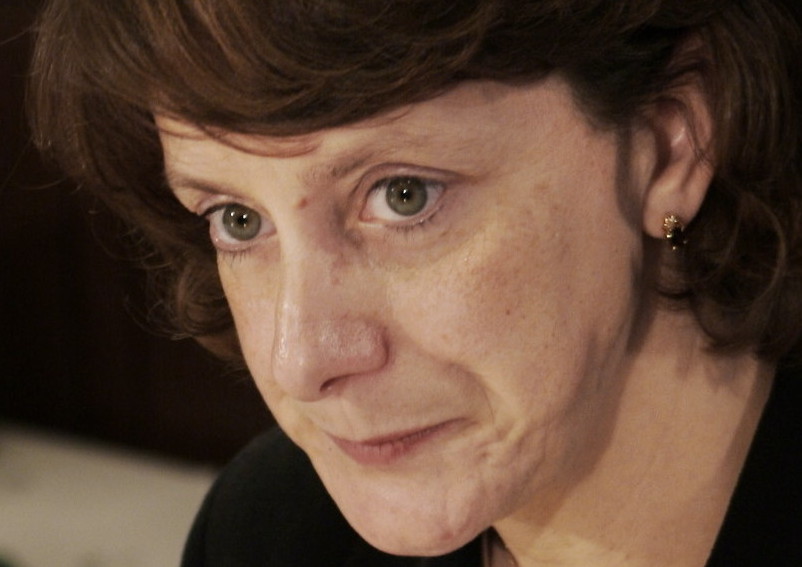Even after deep cuts announced recently at several campuses, the University of Maine System will need to take $11.4 million from emergency reserves to balance the budget for the fiscal year that starts July 1, according to the latest budget proposal.
“This level of deficit spending is not sustainable and is stark evidence that the current operating model is broken,” finance and administration Vice Chancellor Rebecca Wyke wrote in a presentation for the UMS board of trustees Finance Committee, which takes up the proposed $528 million budget on Monday.
The seven-campus University of Maine System expects to eliminate 157 positions, slightly fewer than an earlier projection of 165 jobs, to close a structural deficit of $36 million that officials say is the result of flat state funding, declining enrollment and tuition freezes.
Wyke, who is also treasurer to the board of trustees, said the board and senior leadership must “address this situation and ensure that Maine’s public universities are available for generations to come.”
Trustee Chairman Sam Collins said the deficit spending is “why there needs to be a sense of urgency for changing the model” of the university system. Collins and other adminstrators are increasingly describing a future University of Maine System that collectively offers a portfolio of opportunities, instead of operating as seven independent campuses.
“We need further collaboration among the campuses,” he said. “We have to look at how we do business.”
The emergency funds come from a $15 million budget stabilization fund created in 2010 for the sole purpose of offsetting operating shortfalls at the campuses. This is the first time the one-time funds have been used, officials said.
According to the proposal, $6.9 million in budget stabilization funds will be given to the University of Southern Maine. Other campuses getting funds are: $1.3 million to Fort Kent, $1 million to Presque Isle, $900,000 to Orono, $800,000 to Machias, and $500,000 to Farmington.
Wyke said it remained up to the trustees to decide at their May meeting whether the stabilization funds were a loan that the campuses will have to pay back.
“It remains unclear if it’s a loan or not,” she said Wednesday. “Regardless, (the system) will only transfer the portion actually needed,” in the event that a campus sees a surplus and does not need some or all of the money.
“Once we see where all the chips fall, we’ll see what’s actually needed,” Wyke said.
University of Southern Maine President Theodora Kalikow has announced plans to cut three academic programs and up to 35 staff positions, but that will save only about $7 million, or roughly half the university’s gap of $14 million. That represents 10 percent of the university’s $140 million budget. Some of her cuts remain in flux after she rescinded the layoffs of a dozen faculty members, and is currently working with the Faculty Senate to come up with alternate cuts.
The cuts at USM prompted a series of student protests, and critics who said the university administration should make cuts in other areas, such as administrative costs. The recent news that Wyke got a $40,000 raise in January set off a fresh round of criticism from people who said that indicated there were other areas that could be cut.
Some of the cuts at the local campus level is influenced by whether similar classes or programs are offered at other campuses or online. At USM, for example, the entire Arts and Humanities program is being eliminated at the Lewiston-Auburn College campus. Other programs are increasingly being offered online as well.
The full board of trustees will take up the budget at their May 18-19 meeting in Bangor.
The budget cuts are just the latest wave of cuts and tough budget years for the system. In this fiscal year, the system closed a shortfall of $42 million, and in 2012-13 it closed a gap of $43 million. Since 2007, the system has reduced its work force by 10 percent – 521 full-time equivalent employees.
In this budget year, the work force cuts from layoffs and leaving positions vacant include 50 positions at USM, 37 at Orono, 22 at the system office, 19 at Augusta and 19 at Farmington.
At the University of Maine, officials announced in March that the Orono campus would cut about $10 million in the coming year, about 4 percent of its $249 million budget, without laying off any faculty members or eliminating any academic programs. The cuts would come from leaving positions vacant and laying off about seven non-faculty employees.
The University of Maine at Augusta will cut $2.7 million, mostly by eliminating 24 positions, ending several degree programs and dropping two sports teams. The University of Maine at Farmington says it will cut $1.65 million.
The latest budget proposal notes that some of the systemic issues facing the system are likely to continue, including flat state funding and continued declines in enrollment.
The biggest expense in the budget is compensations and benefits, at $359 million, or 68 percent of the budget.
The biggest revenue generators are student tuition and fees and the state’s annual allocation, which together are $451.6 million.
State funding for the system next year is $178.7 million, which is $6.2 million less than the state appropriated to the system in 2008, Wyke noted. The state appropriation, which used to make up more than half the system revenue just five years ago, is now only 35 percent of revenue. Student tuition and fees, estimated at $272.9 million for the next budget year, is 53 percent of the system’s overall revenue.
Tuition and mandatory fees are $10,700 a year for in-state students at UMaine in Orono and $27,970 for out-of-state students. At USM, tuition and fees are $8,920 for in-state students sand $21,280 for out-of-state students.
Enrollment continues to decline, since they are closely tied to the demographic decline of young adults in Maine, Wyke noted in her report to the committee.
“Maintaining current enrollments will be challenging,” she wrote. As of fall 2013, the state universities had 30,096 students, a decline of about 3 percent from the previous year.
Maine high school graduates are expected to drop from 14,000 in 2008 to about 12,000 in 2020. In-state students make up about 85 percent of the incoming UMaine system freshman class.
Collins and Wyke said the system is taking a multi-pronged approach to get through what Wyke called a “10-year demographic winter,” including more aggressive recruitment of out-of-state and adult students, while at the same time undergoing academic reviews to consider dropping underenrolled programs.
“To buck the demographic that are coming at us, we’re working toward increasing enrollment in any way we can,” Collins said. “(But) we’ve lost 2,000 students since 2007, and so accordingly we have to be sized to fit the new demographics.”
Staff Writer Noel K. Gallagher can be contacted at 791-6387 or at:
Send questions/comments to the editors.





Success. Please wait for the page to reload. If the page does not reload within 5 seconds, please refresh the page.
Enter your email and password to access comments.
Hi, to comment on stories you must . This profile is in addition to your subscription and website login.
Already have a commenting profile? .
Invalid username/password.
Please check your email to confirm and complete your registration.
Only subscribers are eligible to post comments. Please subscribe or login first for digital access. Here’s why.
Use the form below to reset your password. When you've submitted your account email, we will send an email with a reset code.